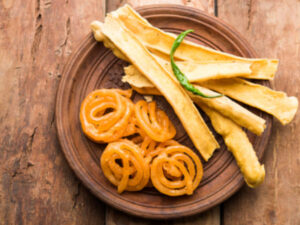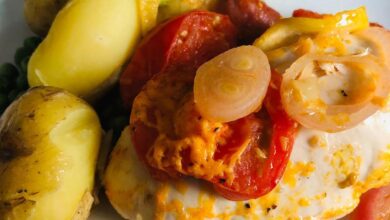Jalebi Fafda Recipe
Jalebi Fafda Recipe

Jalebi Fafda Recipe Introduction:
Jalebi Fafda is a beloved and traditional snack from Gujarat, India, known for its distinctive sweet and savory flavors. This dish pairs crispy, golden-brown fafda—savory, spiced chickpea flour sticks—with sweet, syrup-soaked jalebi, a deep-fried treat with a tangy syrup coating. The contrast between the crunchy fafda and the sticky, sweet jalebi creates a delightful fusion of textures and tastes. Typically enjoyed as a breakfast or snack, Jalebi Fafda is especially popular during festivals and special occasions, offering a satisfying blend of flavors that cater to both sweet and savory cravings.

Jalebi Fafda Recipe Overview:
Jalebi Fafda is a classic Indian combination of two popular snacks from Gujarat. Fafda is a crispy, savory snack made from chickpea flour, seasoned with spices, and deep-fried until golden brown. Jalebi is a sweet, circular dessert made by deep-frying a fermented batter and soaking it in sugar syrup. Together, these two dishes create a unique blend of spicy and sweet flavors that are enjoyed as a special treat or during festivals.
Jalebi Fafda Recipe Ingredient Tips:
Fafda Ingredients:
- Chickpea Flour (Besan):
- Freshness: Use fresh chickpea flour for the best texture and flavor. Stale flour can affect the crispiness of the fafda.
- Sifting: Sift the flour before use to remove any lumps and ensure a smooth dough.
- Carom Seeds (Ajwain):
- Quantity: Use carom seeds sparingly as they have a strong flavor. They add a distinct taste that complements the savory profile of fafda.
- Freshness: Use fresh carom seeds for the best flavor. If they’re old, they might be less potent.
- Turmeric and Black Pepper:
- Balance: Turmeric adds color and a mild flavor, while black pepper adds heat. Adjust these according to your taste preference.
- Quality: Use fresh ground black pepper for a better flavor.
- Baking Soda:
- Purpose: Baking soda helps in making the fafda crispy and light. Ensure it’s fresh for proper leavening.
- Avoid Overuse: Too much baking soda can cause an undesirable taste and affect the texture.
- Oil (for Frying):
- Type: Use neutral oil with a high smoke point, such as vegetable oil or sunflower oil.
- Temperature: Ensure the oil is hot enough (around 350°F/175°C) before frying to achieve a crispy texture.
Jalebi Ingredients:
- All-Purpose Flour:
- Consistency: The batter should be smooth and of a flowing consistency. Adjust with water as needed.
- Sifting: Sift the flour before mixing to avoid lumps in the batter.
- Cornstarch:
- Purpose: Cornstarch helps in making the jalebi crispy. Ensure it’s well-mixed with the flour.
- Yogurt:
- Fermentation: Yogurt helps in fermenting the batter, which is essential for the texture of jalebi. Use fresh, plain yogurt.
- Quantity: Adjust the amount of yogurt based on the consistency of the batter. Too much yogurt can make the batter too runny.
- Baking Powder:
- Purpose: Baking powder aids in the batter’s rise and helps create the crispy texture. Ensure it’s fresh for best results.
- Sugar:
- Quality: Use granulated sugar for the syrup. Avoid using powdered sugar as it can alter the syrup’s consistency.
- Water (for Syrup):
- Proportion: Maintain the correct ratio of water to sugar to achieve a thick but pourable syrup. Too much water can make the syrup too thin.
- Cardamom Pods:
- Flavor: Crush cardamom pods to release their essential oils for a fragrant syrup. You can adjust the amount based on your taste preference.
- Saffron (Optional):
- Flavor and Color: Saffron adds a unique flavor and golden color to the syrup. Use sparingly as it has a strong taste.
- Rose Water (Optional):
- Enhancement: Rose water adds a floral aroma to the syrup. Use it lightly to avoid overpowering the flavor.
General Tips:
- Consistency: For both fafda and jalebi, ensure the batter or dough is of the right consistency. It should be neither too thick nor too runny.
- Resting Time: Allow the fafda dough and jalebi batter to rest for the recommended time to develop the flavors and achieve the best texture.
- Testing: Before frying a large batch, test a small amount of the batter or dough to check the texture and flavor. Adjust if necessary.
For Fafda:
- Mixing Bowls:
- Use medium to large bowls for mixing the chickpea flour (besan), spices, and water to make the fafda dough.
- Rolling Pin and Board:
- To roll out the fafda dough into thin, even sheets. Ensure the rolling surface is clean and lightly floured to prevent sticking.
- Knife or Pizza Cutter:
- To cut the rolled dough into strips or desired shapes for frying.
- Frying Pan or Deep Fryer:
- A deep frying pan or a deep fryer for frying the fafda. Ensure it is deep enough to submerge the fafda strips in hot oil.
- Slotted Spoon or Spider Strainer:
- For removing the fafda from the hot oil. A slotted spoon or spider strainer helps drain excess oil.
- Paper Towels:
- To place the fried fafda on, allowing excess oil to be absorbed.
- Cooling Rack (Optional):
- To cool the fafda evenly and maintain its crispiness. Place it on a cooling rack to prevent sogginess.
For Jalebi:
- Mixing Bowls:
- For preparing the jalebi batter. Use a large bowl to mix flour, cornstarch, yogurt, and water.
- Piping Bag or Squeeze Bottle:
- For piping the jalebi batter into the hot oil to form spirals. If you don’t have a piping bag, a squeeze bottle with a small nozzle works well.
- Frying Pan or Deep Fryer:
- Similar to the fafda, use a deep frying pan or deep fryer. The pan should be wide enough to allow easy swirling of the batter.
- Saucepan:
- For preparing the sugar syrup. A medium saucepan is ideal for boiling water and sugar with cardamom.
- Thermometer:
- A candy or deep-fry thermometer helps monitor the temperature of the oil and syrup, ensuring they are at the correct temperatures for frying and setting.
- Slotted Spoon or Spider Strainer:
- For removing the fried jalebi from the oil and dipping it into the syrup.
- Cooling Rack or Plate:
- To place the fried jalebi on after dipping it in syrup, allowing excess syrup to drip off and prevent sogginess.
- Parchment Paper or Silicone Mat:
- To line the cooling rack or plate, making cleanup easier and preventing sticky jalebi from sticking to the surface.
General Tips:
- Prep Space: Ensure your workspace is clean and organized to facilitate smooth preparation and cooking.
- Safety Gear: Use heat-resistant gloves or mitts if needed, and always handle hot oil with care to avoid burns.
Jalebi Fafda Recipe Step-by-Step Instructions:
Instructions:
- Prepare the Dough:
- In a mixing bowl, combine chickpea flour, carom seeds, turmeric powder, black pepper, salt, and baking soda.
- Add 2 tablespoons of oil to the dry ingredients and mix well.
- Gradually add water, a little at a time, to form a smooth and firm dough. The dough should be pliable but not too soft.
- Rest the Dough:
- Cover the dough with a damp cloth and let it rest for about 15-20 minutes. This helps in making the dough more workable.
- Roll and Cut:
- On a lightly floured surface, roll out the dough into a thin, even sheet (about 1/8 inch thick).
- Using a knife or pizza cutter, cut the rolled dough into thin strips (about 1/2 inch wide).
- Heat the Oil:
- In a deep frying pan or deep fryer, heat enough oil for deep frying over medium-high heat. The oil should be around 350°F (175°C).
- Fry the Fafda:
- Gently slide the dough strips into the hot oil, a few at a time, to avoid overcrowding.
- Fry until golden brown and crispy, turning occasionally for even cooking. This should take about 2-3 minutes per batch.
- Remove the fafda with a slotted spoon and place them on paper towels to drain excess oil.
- Prepare the Batter:
- In a mixing bowl, combine all-purpose flour, cornstarch, and baking powder.
- Add yogurt and mix well to form a smooth batter. Gradually add water to reach a slightly thick, pourable consistency.
- Cover the bowl and let the batter rest for 2-3 hours to ferment.
- Prepare the Syrup:
- In a saucepan, combine sugar, 1 cup of water, and crushed cardamom pods. Add saffron strands if using.
- Heat over medium heat, stirring until the sugar dissolves. Allow it to simmer for 5-7 minutes until it slightly thickens.
- Remove from heat and add rose water if using. Keep the syrup warm.
- Heat the Oil:
- In a deep frying pan or deep fryer, heat oil to around 350°F (175°C) for frying the jalebi.
- Pipe the Jalebi:
- Transfer the batter to a piping bag or squeeze bottle with a small nozzle.
- Pipe the batter into the hot oil in a spiral or circular motion to form jalebi shapes. Fry until golden brown and crisp, about 2-3 minutes per side.
- Dip in Syrup:
- Remove the fried jalebi from the oil using a slotted spoon.
- Immediately dip the jalebi into the warm sugar syrup, ensuring it’s well-coated.
- Remove from the syrup and place on a cooling rack or plate lined with parchment paper to drain excess syrup.
Serving:
- Serve Warm: Serve the freshly made fafda and jalebi together. Fafda can be enjoyed as a crispy, savory snack with pickles or chutneys, while jalebi adds a sweet, sticky contrast.
- Accompaniments: Consider serving with a side of yogurt or a spicy chutney to enhance the flavors.
Top of Form
Bottom of Form
Jalebi Fafda Recipe Tips and Tricks:
- Dough Consistency:
- Firmness: Ensure the dough is neither too soft nor too stiff. It should be pliable and easy to roll out. If it’s too soft, add a bit more chickpea flour; if too stiff, add a small amount of water.
- Rolling the Dough:
- Thickness: Roll the dough as thin as possible for extra crispiness. A thin layer will fry up more crispy and light.
- Surface: Use a lightly floured surface to prevent sticking. Alternatively, roll the dough between two sheets of parchment paper.
- Cutting the Dough:
- Uniform Strips: Cut the dough into uniform strips to ensure even frying. If you prefer, you can also shape them into thin sticks or squares.
- Oil Temperature:
- Heat: Maintain the oil temperature around 350°F (175°C). Too hot and the fafda will brown too quickly without cooking through; too cold and they will absorb too much oil.
- Test: Test a small piece of dough in the hot oil to check the temperature. It should rise to the surface and start bubbling immediately.
- Frying Tips:
- Avoid Overcrowding: Fry in batches to avoid overcrowding, which can lower the oil temperature and lead to soggy fafda.
- Drain Well: Place fried fafda on paper towels to absorb excess oil, keeping them crispy.
For Jalebi:
- Batter Consistency:
- Smoothness: The batter should be smooth and slightly thick, similar to pancake batter. Adjust with water or flour as needed.
- Resting: Allow the batter to ferment for 2-3 hours. This helps develop a better texture and flavor.
- Syrup Preparation:
- Thickness: The syrup should be slightly thick but not too sticky. Test by dropping a spoonful into cold water; it should form a soft ball but not be overly firm.
- Warm Syrup: Keep the syrup warm (but not hot) so it coats the jalebi properly. Cold syrup can cause the jalebi to lose its crispiness.
- Piping the Jalebi:
- Consistency: Use a piping bag or squeeze bottle with a small nozzle for control. Practice piping on a small portion of oil to perfect your technique before making a full batch.
- Shapes: Create spiral or circular shapes. Don’t worry about perfect shapes; they’ll still taste delicious even if they’re a bit irregular.
- Frying Tips:
- Temperature Control: Maintain oil temperature around 350°F (175°C) to ensure even frying and crispiness. Adjust the heat as needed during frying.
- Frying Time: Fry jalebi until golden brown and crisp. Over-frying can make them too hard, while under-frying can leave them soft.
- Dipping in Syrup:
- Immediate Dipping: Dip the jalebi into warm syrup immediately after frying. This allows the syrup to be absorbed while the jalebi is still hot and crispy.
- Avoid Over-Dipping: Do not soak the jalebi in syrup for too long to prevent them from becoming soggy. A quick dip is usually sufficient.
General Tips:
- Preparation: Prepare all ingredients and equipment before starting to streamline the cooking process.
- Testing: Always test a small batch of both fafda and jalebi to ensure the recipe works as expected and adjust as needed.
- Storage: Store leftover fafda in an airtight container to maintain crispiness. Jalebi should be stored in a covered container at room temperature and consumed within a day or two for best results.
Serving Suggestions:
Jalebi Fafda is a versatile dish that can be enjoyed in various ways. Here are some serving suggestions to elevate your experience:
- Classic Combination:
- Traditional Serve: Enjoy Jalebi and Fafda together on a plate. The crisp, savory fafda pairs perfectly with the sweet, sticky jalebi. This classic combination is especially popular for breakfast or as a festive treat.
- With Chutneys and Pickles:
- Mint Chutney: Serve fafda with a side of fresh mint chutney for a refreshing, spicy contrast.
- Tamarind Chutney: Add tamarind chutney to balance the sweetness of jalebi with a tangy twist.
- Pickles: Spicy Indian pickles, like mango or lemon pickle, add an extra layer of flavor and heat to the fafda.
- With Yogurt:
- Plain Yogurt: Serve fafda with a side of plain yogurt to balance the spice and provide a creamy contrast.
- Yogurt with Spices: Mix yogurt with a pinch of cumin, salt, and a bit of chaat masala for a flavored dip that complements the fafda.
- As a Festive Breakfast:
- Special Occasion: Jalebi Fafda is a popular choice for festive breakfasts and special occasions. Serve it with a side of tea or coffee to make it a hearty start to the day.
- With Fresh Fruits:
- Fruit Salad: Pair the dish with a fresh fruit salad to add a light, refreshing element that complements the rich and sweet flavors of jalebi.
- With Saag or Curry:
- Accompaniment: For a savory twist, serve fafda alongside a simple saag (spinach) or curry. The crispy fafda can be enjoyed as a crunchy accompaniment to the curry.
- As Part of a Snack Platter:
- Platter: Create a snack platter by including a variety of Indian snacks, such as samosas, pakoras, and kachoris, along with jalebi and fafda. This makes for a delightful and diverse snack experience.
- With Additional Toppings:
- Chopped Onions and Coriander: Garnish fafda with finely chopped onions and fresh coriander for added flavor and a touch of freshness.
- Lemon Wedges: Serve with lemon wedges for an optional squeeze of tangy citrus that can enhance the flavor of the fafda.
- For a Sweet Finish:
- Garnishes: Garnish jalebi with a sprinkle of chopped nuts, such as almonds or pistachios, for added texture and visual appeal.
Tips for Serving:
- Warm or Room Temperature: Jalebi is best served warm or at room temperature to maintain its syrupy texture. Fafda should be served crisp to enjoy its crunch.
- Presentation: Arrange the jalebi and fafda attractively on a platter to enhance the visual appeal. Use garnishes and accompaniments to create a well-rounded presentation.
FAQs:.
1. What is the best time to enjoy Jalebi Fafda?
Answer: Jalebi Fafda is traditionally enjoyed as a breakfast or brunch item, especially on festive days like Dussehra and Diwali. It is also a popular snack during the day or as an indulgent treat during special occasions.
2. Can I prepare the batter and dough in advance?
Answer: Yes, you can prepare the fafda dough and jalebi batter a few hours ahead of time. For best results, make the fafda dough and jalebi batter fresh. However, you can refrigerate the batter for up to 4 hours before frying.
3. How do I store leftover Jalebi Fafda?
Answer: Store leftover fafda in an airtight container to keep it crispy. For jalebi, store it in a covered container at room temperature. Jalebi is best consumed within 1-2 days as it can become sticky and lose its crispiness over time.
4. What can I do if my fafda dough is too soft?
Answer: If the fafda dough is too soft, add a little more chickpea flour to achieve the desired consistency. It should be firm enough to roll out without sticking excessively.
5. Why is my jalebi batter not fermenting properly?
Answer: Ensure that the yogurt used is fresh and that the batter is left in a warm place to ferment. The ambient temperature should be warm enough to facilitate fermentation. If it’s too cold, the batter might not rise properly.





